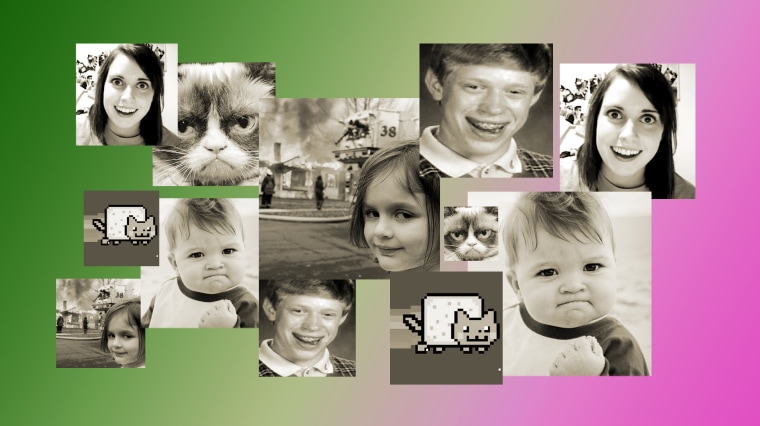The image of Zoe Roth, her small face grinning somewhat ominously at the camera while firefighters work to save a burning home behind her, has made the rounds online for years.
The image of Roth, taken in 2005 near a planned and controlled burn, became an iconic meme known as "Disaster Girl."
Now, 16 years after the image was snapped, "Disaster Girl" has made Roth, 21, roughly $430,000.
Like Roth, an influx of viral celebrities featured in classic memes have minted and sold their images as NFTs, or non-fungible tokens. Since the beginning of the year, memes have had a kind of NFT "gold rush," experts say.
"It's been really fascinating to watch how this gold rush has happened," said Don Caldwell, editor-in-chief of the meme cataloging and research website Know Your Meme. "As far as it goes with becoming a meme, it's very difficult to monetize that. We've spoken to numerous people who have become memes and have had a lot of difficultly making money off their creations."
NFTs work as a sort of certificate of authenticity. Rather than the NFT owner holding a sheet of paper that states a work's authenticity, the NFT is a string of unique characters. Those characters are connected to a blockchain, a group of computers that act as a digital ledger that no one computer can change. The same concept powers cryptocurrencies like bitcoin, but whereas bitcoins are all essentially the same, NFTs are non-fungible, or unique.
Roth is part of a unique club of people who went viral by accident and were launched to massive digital fame. These meme stars have had their faces plastered across the internet, used as ways to convey reactions or emotions with relative anonymity despite their fame — a casual internet user likely doesn't know Roth's name or that she's "Disaster Girl."
This unusual type of fame usually offered little in the way of financial upside to its subjects until NFTs exploded in recent months.
As NFTs went mainstream — with artists, sports leagues, celebrities and many others jumping into the market — meme creators decided to get in on the action.
Staples of traditional internet memes like "Bad Luck Brian," whose real name is Kyle Craven; "Overly Attached Girlfriend," whose real name is Laina Morris; and "Success Kid," a photograph taken by Laney Griner of her son, Sam, have all sold in recent months as NFTs.
Roth sold her image as an NFT on April 17 for 180 ether, a cryptocurrency recorded on the blockchain Ethereum and equals roughly $2,200 per unit, according to MarketWatch. In early April, Morris sold her "Overly Attached Girlfriend" meme for about $411,000. In March, Craven sold "Bad Luck Brian" for around $36,000.
The meme NFTs do not imply the meme creator nor the buyer "owns" the meme like a copyright and therefore cannot prevent the spread or use of the meme, according to Decrypt, a website that covers cryptocurrency. The NFT is more like a digital autograph from the meme creator, Decrypt reported, certifying authenticity — similar to an autographed baseball card.
Experts say the desire to purchase memes as NFTs is the same as buying an original piece of art, rather than a re-creation or a reprint. The NFT acts as a sort of certificate of authenticity. And the interest in buying minted NFTs has given what some may consider a "dead meme," a meme that was once popular but has since lost its stature, a second life.
"The reason that we're talking about NFTs in this way is because you have people who spent millions of dollars on these works, and therefore because there's a lot of money involved, the spotlight comes on them," said Shane Tilton, associate professor of multimedia journalism at Ohio Northern University and the author of the upcoming book "Meme Life." "It basically gave meme creators a chance to re-promote their work because now there's a spotlight and stage to show their work to either a new audience or an audience that had forgotten."
Caldwell said the origins of meme NFTs can be traced back to 2018, when a Peter Kell bought an NFT meme know as "Homer Pepe" — a piece of crypto art that looks like an amalgamation of the internet meme "Pepe the Frog" and Homer Simpson from "The Simpsons." Kell purchased the "Rare Pepe," as it was known, for approximately $39,000, according to Know Your Meme. Earlier this year, Kell resold the NFT for approximately $312,000, Know Your Meme reported.
"This year is when we really saw NFTs in general explode and with that came meme creators selling their memes," Caldwell said.
Although a slew of notable memes have sold as NFTs, Caldwell said the person who arguably kicked off the recent "gold rush" was Chris Torres, the creator of the pixel art "Nyan Cat," a cat with a Pop-Tart body running ahead of a rainbow trail, who sold his creation for roughly $580,000, according to The New York Times.
"All these meme creators began minting their NFTs on this marketplace called Foundation, which is one of the more popular ones for these creators," Caldwell said.
Torres was friends with many of the meme creators, Caldwell said, and advised others on selling their creations as NFTs.
Caldwell said, for now, established, years-old memes seem to be most in demand among NFT buyers. He added that he wouldn't be surprised if newer memes try to mint their creations as NFTs and cash in on the windfall.
"So far, we've mostly seen these established memes that are iconic and have been around for a decade or more. That's who's paved the way so far, but I wouldn't be surprised if newer memes and newer meme creators started having success minting their NFTs," he said. "It's all kind of up in the air though."


